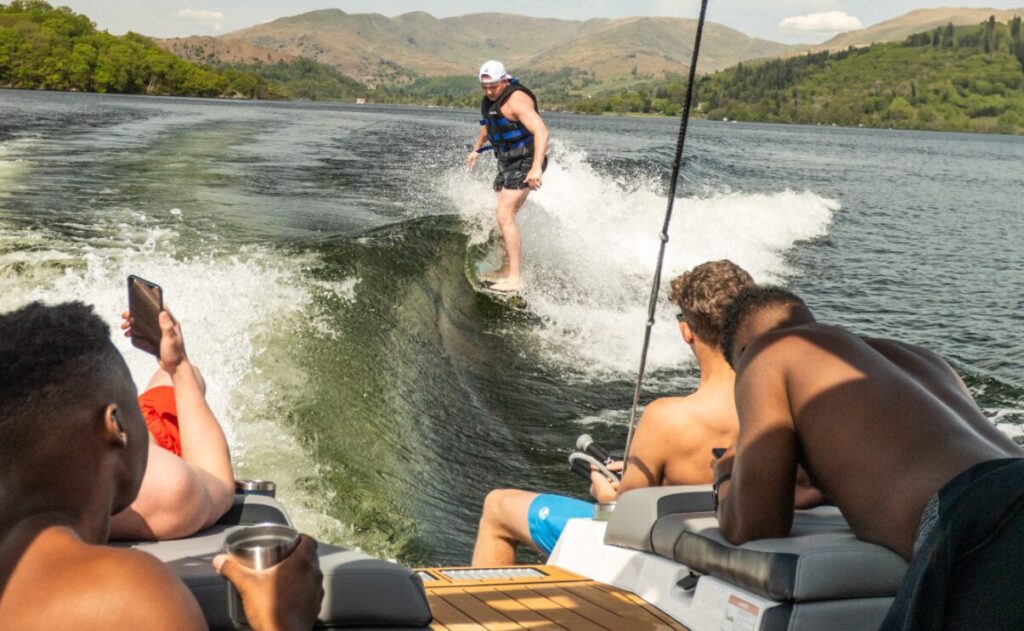If there’s one challenge we see time and time again, whether it’s someone’s first time wakesurfing or their fiftieth, it’s staying balanced on the wave. So, we wanted to share a few of our go-to tips for keeping steady and confident once you’re up and surfing.
Whether you’re brand new to wakesurfing or looking to fine-tune your skills, you’re in great hands. Our fully insured, BWSW-accredited instructors (that’s British Water Ski & Wakeboard, the UK’s governing body) ensure you’re learning from the best in the business. You’ll not only feel more confident, but you’ll progress faster with expert coaching tailored to you.
New to wakesurfing? Before you dive into the balance tips below, it might help to understand the difference between wakesurfing and wakeboarding—especially if you’re coming from a wakeboarding background. And if it’s your very first time on the water, check out our guide on how to wakesurf for the first time for a step-by-step breakdown of what to expect.
We Start by Getting the Right Wave (Thanks, Nautique)

Before we dive into balance tips, let’s talk about the boat. It’s not just about technique. Having the right setup can make a huge difference.
We use a top-of-the-line Nautique boat at Windermere Wakesurfing. Why? Because it creates consistent, customisable waves that make learning (and progressing) much easier. The Nautique Surf System (NSS) lets us adjust the wave’s size and shape, so whether you’re just starting out or already carving turns, the wave works with you.
Plus, with features like WAVEPLATE tech and speed control, you get a smooth, predictable wave every time. And for those cheering you on? The boat is comfy and spacious, with unbeatable views of the lake.
Let’s Talk Balance: Our Top Tips for Staying Upright on the Wake

Once you’re up on the board, it’s all about staying in control. Here are a few key things we focus on during our sessions:
- Stay Low and Relaxed
This one’s simple, but so effective. Bend your knees slightly and keep your stance relaxed. Lowering your centre of gravity helps you respond to changes in the wave without overreacting.
A low stance doesn’t just look more confident, it gives you more control. Over time, this will start to feel totally natural, especially as you learn to “read” the wake better. - Use Your Core
It’s not just your legs doing the work. Your core plays a massive role in staying balanced. Keeping your core engaged helps steady your upper body, which is key when the wave shifts or bumps come along.
Think of your core as your internal stabiliser. The more connected you feel through your middle, the smoother your surf will be. - Be Ready to Adjust
No two sessions on Lake Windermere are exactly alike. Wind, boat speed, and even the direction of the wake can all affect how it feels.
Staying balanced means staying adaptable. Make small shifts in your weight, forward, backward, side to side—as needed. Avoid big, jerky movements. Instead, keep things subtle and in tune with the rhythm of the wave. - Stay Connected with Two-Way Helmets
One of the things that sets us apart is our use of BB Talking two-way helmet systems. These let you stay in constant communication with your coach, even while you’re surfing the wave.
It means you get real-time tips, encouragement, and feedback as you go, helping you learn faster and with more confidence. No more shouting from the boat or waiting until you’ve fallen to correct a mistake—just clear, calm guidance when you need it most. - Choose the Right Board
Having the right gear matters. A board that suits your size and skill level can seriously help your stability. Generally, boards with a bit more surface area are more forgiving and easier to balance on—great for beginners.
We’ve had plenty of students improve instantly just by switching boards. During your lesson, we’ll make sure you’re on the best setup for your ability and the conditions. - Practice, Practice, Practice
There’s no shortcut here, the more time you spend on the water, the better your balance will get. Every wipeout teaches you something, and every surf builds muscle memory.
We had one surfer who struggled to stay up for more than a few seconds at first. But after an hour or so they started to find their rhythm. A few sessions later, they were confidently surfing.
Progress doesn’t always come quickly, but it does come. Stick with it. - Stay Calm and Focused
Balance isn’t just physical it’s mental too. If your mind’s racing or you’re tense, it’ll show in your body. A clear, calm mindset helps you react better and move more naturally on the board.
Before you surf, take a moment to breathe and centre yourself. It might sound simple, but it can make all the difference.
Getting good Balance Comes with Time (and a Little Help)

Staying balanced on a wakesurf board is all about practice, body awareness, and learning to trust yourself on the wave. At Windermere Wakesurfing, we’re here to guide you every step of the way—whether you’re learning the basics or building toward more advanced manoeuvres.
With our BWSW -accredited instructors, cutting-edge communication helmets, and top-tier equipment, you’ve got everything you need to progress safely, confidently, and at your own pace.
Ready to surf? Check out our wakesurfing lessons and book your session today.



